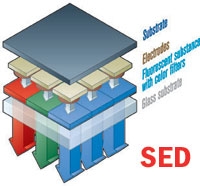The Future of Flat-Panel TVs Page 2
THE CONTENDERS
Since there's plenty of money to be made as Americans upgrade to high-def over the next decade, you'd think there'd be heaps of new flat-TV technologies on the way. But only two serious contenders are currently in development.
The first, Surface-conduction Electron-emitter Display (SED), was jointly developed by Canon and Toshiba and is intended for big-screen (50 inches and larger) TVs. To judge from demos at recent trade shows, SED's stunning picture quality will make it a formidable flat-panel competitor - if it ever makes it to market. Toshiba planned to release models earlier this year, but the rapid price erosion of plasma and LCD TVs sent developers back to the lab to figure out a more cost-effective way to manufacture SED sets. The latest word is that Toshiba plans to introduce SED to coincide with the 2008 Summer Olympics in Beijing.
The other flat technology in the queue, Organic Light-Emitting Diode (OLED), is being positioned as a successor to LCD. You can already find small OLED screens in digital cameras, camcorders, portable audio and video players, cellphones, and PDAs. But big-screen versions are also in the works: Sony recently exhibited a strikingly slim 13-inch computer monitor, while both Samsung and Epson have shown prototype 40-inch widescreen HDTVs. However, as with SED, the stiff competition from ever cheaper plasma and LCD sets might keep OLED out of the market for a while. There are also some technical hurdles to overcome, with the life expectancy of displays currently hovering well below that of the competing flat-panel technologies. Still, it's anticipated that bigscreen OLED HDTVs could arrive sometime around 2010.
 SED :: Potential Plasma-killer Toshiba and Canon's recipe for a new flat screen draws from both plasma and old-school cathode-ray tube (CRT) TVs. Light is produced by phosphor dots coating the inside of the screen. In an SED display, these are masked with red, green, or blue filters. (Each trio of colored subpixels forms a single pixel.) In a plasma set, phosphors are triggered by cells containing a gaseous mixture that discharges in reaction to a flow of electrical current; in a CRT screen, they're barraged by magnetically steered electron beams fired from "guns" in the tube's neck.
SED :: Potential Plasma-killer Toshiba and Canon's recipe for a new flat screen draws from both plasma and old-school cathode-ray tube (CRT) TVs. Light is produced by phosphor dots coating the inside of the screen. In an SED display, these are masked with red, green, or blue filters. (Each trio of colored subpixels forms a single pixel.) In a plasma set, phosphors are triggered by cells containing a gaseous mixture that discharges in reaction to a flow of electrical current; in a CRT screen, they're barraged by magnetically steered electron beams fired from "guns" in the tube's neck.
SED, in contrast, uses a grid of emitters, each of which fires electrons directly at a specific phosphor dot located on the panel's screen. Because the space between the emitter array and the screen is extremely narrow, an SED panel is only a few centimeters thick - kind of like tube technology without the tube.
SEDs have many of the same things going for them that plasmas do: They're thin, have a wide viewing angle, and display fast-moving images clearly. But they also have the capability of topping plasma (and LCD, DLP, and LCoS as well) when it comes to contrast ratio - something that's proven to be the Achilles' heel of the new generation of post-tube displays.
- Log in or register to post comments



































































